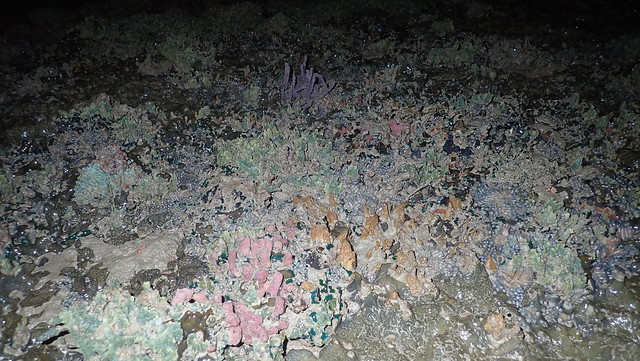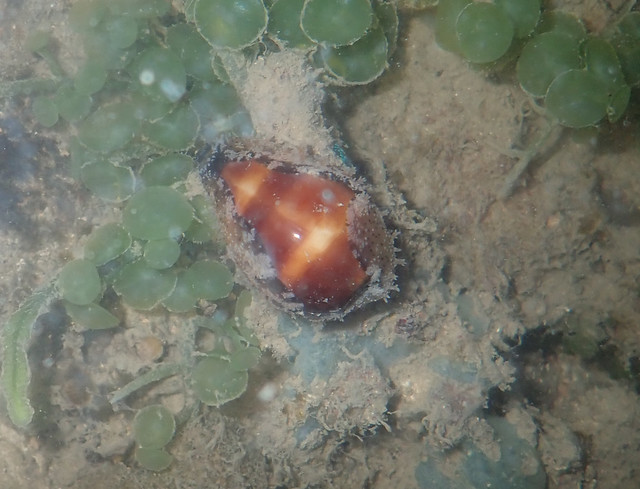Our annual trips to Beting Bronok are bitter-sweet. Like visiting our favourite grandma and watching her painfully, slowly fade away. I feel privileged to have seen her at her best.
There are still patches densely covered in sponges. But most of the area was covered with scummy growths.
The most abundant sponge were Yellow bumpy sponges, which seemed to dominate this shore since our survey in Aug 2015. Today, they really took over a large area near our landing point. The Barrel sponges appear to be doing well too, with one particularly large specimen. There were a variety of other sponges in small clumps.
With so many sponges and things to eat, it's not surprising to see many nudibranchs. It was nice to see several of the Ceratosoma gracillimum nudibranch that we had been seeing in recent years. I also saw a large Atagema spongiosa which resembles a sponge, the pretty Cuthona sibogae and a Bornella stillifer. The rest of the team saw other kinds of nudibranchs including Blue dragons,
and some nudis we have not seen before.

Another animal that eats immobile creatures is the flatworm. Today, we saw lots of Spangled flatworms as usual. The rest of the team saw other kinds of flatworms.
I saw some hard corals, but much fewer than on our last survey in Jun 2018. I saw some Boulder pore corals and Branching pore corals and a small patch of Neat hexa corals. I did not come across the colonies of Anemone coral which I saw in Jun 2018. The rest of the team saw some other species of corals.
I saw many small Spiky flowery soft corals and a few small Pink flowery soft corals. I saw a False cowrie in one - this snail looks like the soft coral and eats it. But I did not see any Ball flowery soft corals.
There were some sea fans in a small corner, the most common being Candelabra sea fans and Gnarled sea fans, as in the past. I also saw one small Asparagus sea fan, and a bright purple sea fan and orange sea fan that I can't identify. I saw one Winged oyster that lives in sea fans. There were a lot of large Stinging hydroids as well as many other branching cnidarians.
Button zoanthids still cover large areas of the flat, very densely in some parts. I did not see any Sea mat zoanthids.
I saw fewer echinoderms compared to our survey in Jun 2018. I saw only one large Biscuit sea star and the rest of the team saw only a few Knobbly sea stars (we saw 15 last year). I saw one Blue feather star and a few Orange sea cucumbers. The rest of the team saw Ball sea cucumbers and some large Basket stars! I only saw one Haddon's carpet anemone, unlike the many that I saw in Jun 2018. I saw one Swimming anemone and a few cerianthids. I saw some Flowery sea pens and one sea pencil, but did not see any Spiky sea pens. The rest of the team saw a Haekel's anemone, Snaky anemone, and Glass anemone.
I saw many fishes today. Filefishes were abundant in the pools, and I saw one Copperband butterflyfish, two Peacock soles, one Pink eared emperor and one small Blue spotted fantail ray. The rest of the team saw a baby shark, moray eel and a seahorse! There were lots of small Swimming crabs everywhere, many Stone crabs and I saw one Red egg crab.
The rest of the team saw tiny octopuses, white and pale, stranded at low tide. I saw one small Noble volutes and one Onyx cowrie.
I saw sprinkles of Spoon seagrasses that were heavily covered in epiphytes, similar to our survey in Jun 2017. Last year in Jun 2018, I saw more seagrass covering a larger area and their leaf blades were quite free of epiphytes.
Unlike our survey in Jun 2018, we didn't come across any fish traps today. But throughout the predawn survey, there was the sound of heavy machinery at Tekong. At sunrise, we could see huge piles of sand piled up behind the seawall. On the way home, we observed a lot of reclamation activity on Tekong.
Beting Bronok remains a pale shadow of itself. This is what the shore looked like in years past...
 |
| Not very lively today, Jul 2019. |
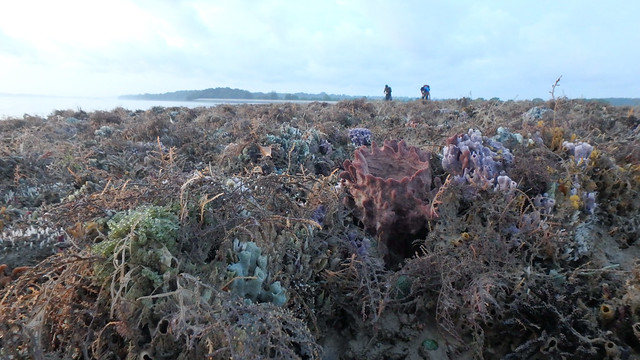 |
| Some signs of recovery in Jun 2018. |
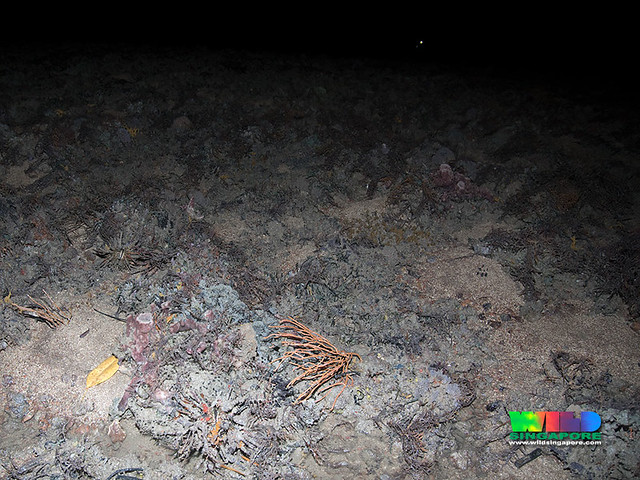 |
| A bit more marine life in 2017. |
 |
| Growths of marine life in Jun 2016. |
 |
| Mostly zoanthids only on the shore, Aug 2015 |
 |
| Marine life on at Beting Bronok in 2014 |
 |
| Marine life on Beting Bronok in 2013. |
 |
| Colourful marine life at Beting Bronok in 2012. |
 |
| Beting Bronok in 2012. |
 |
| Beting Bronok in 2003. |
 |
| Beting Bronok in 2003. |
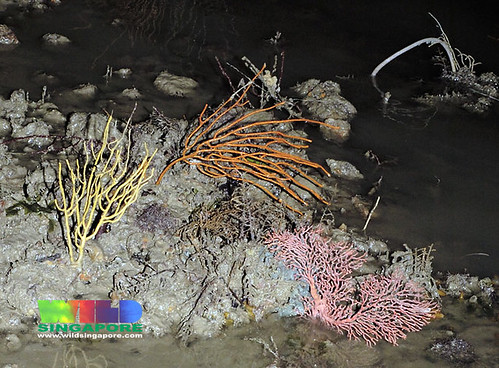 |
| Sea fans on Beting Bronok in 2004. |
Thanks to Chay Hoon for organising the trip.
Where is Beting Bronok? What is it's status and future?
When the 2030 landuse plan by the Ministry of National Developmentwas announced, it was also announced that Beting Bronok and Pulau Unum have been granted 'Nature Area' status. As I understand it, this status means the area "will be kept for as long as possible until required for development". Here's an earlier about 'Nature Area' status seem to mean.
To me, Beting Bronok seems to be in steady decline since the reclamation started at nearby Pulau Tekong . It has since also been affected by the flooding that led to mass deaths at Chek Jawa in 2007, and the coral bleaching in 2010 and a ferry ran aground on Beting Bronok in Jul 2011. Development of Pengerang Johor for a petrochemical complex that was rejected in Taiwan for environmental and health reasons can also impact Beting Bronok.
Now, with massive reclamation at Tekong, we can only hope for the best for this wonderful reef on our Northern shore.
Posts by others on this trip
Loh Kok Sheng
Jianlin Liu
Vincent Choo
Richard Kuah
Abel Yeo
Chay Hoon
Marcus Ng
Choo Yi Feng
Kelvin Yong


